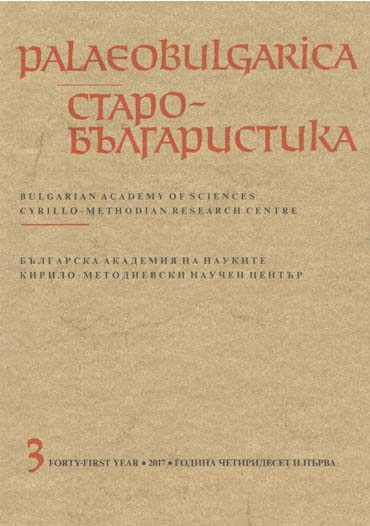The Graphemic Coordinates of the Old Church Slavonic-Glagolitic Horologion-Fragment from Sinai
The Graphemic Coordinates of the Old Church Slavonic-Glagolitic Horologion-Fragment from Sinai
Author(s): Heinz MiklasSubject(s): Language studies
Published by: Кирило-Методиевски научен център при Българска академия на науките
Summary/Abstract: In 2011 a new Glagolitic fragment came to the fore at St. Catherine’s monastery. It was recently published by N. Glibetić (2015). The manuscript consists of one single, badly damaged folio. Comparing it with Greek and Slavic counterparts, Glibetić found out that its text probably derives from a časoslov written in the Sinai. During the preparation of her study we discussed the age of the fragment and the possible origin of its scribe. On the basis of paleographic and linguistic data we reached the conclusion that it very likely belongs to the first half, if not first quarter, of the 11th century and can either be attributed to the Northwest of the Macedonian region or, rather, an adjacent area further north. In this article these assumptions are verified by comparing the graphemic evidence of the fragment. In Miklas, Hürner 2015 it could be shown that Old Bulgarian documents can be dated and localized by a numerical calculation of their graphemic features. The method works well if the source material is sufficient to calculate at least ten out of twenty features. In this document we can trace ten with confidence; two others are not fully reliable due to a lack of text. In two cases we have to complement the list of subfeatures because the relevant graph ö occurs for the first time in practical use (three times in the endings of поö and [айЌль]скоö), while Ik (Ý) had not been registered in the relevant ‘Jesu(s)’-position ([и]сŤÝ хŤ[е]) before. Not to be counted is Dzělo because it occurs only as a numerical figure, nor Ik as an independent /u/-representative, since here it only replaces Ypsilon in the mentioned ending. Two counts result in the following data: Calculation 1 gives ca. 983 – 1006 (closest to the Rila fragments), and the redactional area Bc – Bd (a border-value closest to the Cod. Marianus). Calculation 2 gives the years ca. 1006 – 1007 (closest to Cod. Clozianus), and the redactional area Bc. The second calculation appears to be more plausible, although the first cannot be entirely ruled out. The redactional results are supported by Western features. Consequently, the text of the manuscript was most likely written in the first decade of the 11th century, and its scribe (a second, younger hand can be observed in a short correction on the verso-side) represents a school from the west of the Zeta-Hum area, in those days still primarily Serbian dominated Duklja, Travunja and Zahumlje.
Journal: PALAEOBULGARICA / СТАРОБЪЛГАРИСТИКА
- Issue Year: 2017
- Issue No: 3
- Page Range: 3-18
- Page Count: 16
- Language: English
- Content File-PDF

